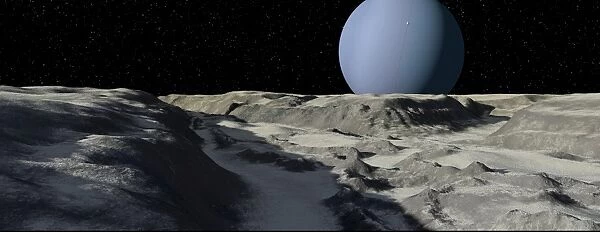what to see on
ariel
For a scenic view, and an answer-page for Guess The World...
 by Ron Miller
by Ron Millersinister laboratory on ariel
Captain Future uttered a relieved exclamation.
"Ah, there's what we're looking for - Skal Kar's stockade."
Ahead yawned a thousand-foot clearing that had been hacked from the jungle. It was surrounded by a wire stockade, to which were connected cables from a squat atomic electric-generator. The generator kept the wire stockade charged, and the gliding white gas-beasts that swarmed outside dared not approach it.
At the center of the clearing looked the mysterious laboratory of the murdered scientist. It was a black cement tower, windowless, cylindrical in shape. Curt brought the Comet down to an expert landing inside the stockade. He cut the cycs, then rose to his feet.
"Looks like the place is deserted," he told the Futuremen, "but we'll take no chances. Be ready for a scrap in there..."
Edmond Hamilton, The Magician of Mars (1941, 1968)
launch site on ariel
...I was watching a strange, unearthly scene. There was a whole crowd of men such as the one I had met. They were gathered around what looked like a huge wheel, at least fifty feet in diameter. This wheel was attached to a great mass of machinery by means of a large axle.
Hanging on the bottom of a wheel was a small egg-shaped vehicle. Set in the side of this was a circular doorway whose thick metal door was open. Before this was a being whom I instantly knew to be he whom I had met. The other people were gathering around him talking in an utterly incomprehensible tongue.
This
whole scene was set in a huge clearing before what looked to be a small
city of curious hemispherical buildings. The horizon of this strange
world was very close. The curvature could be distinctly made out. The
sky was a deep blue, and overhead, filling most of it, was a vast
greenish sphere...
Donald A Wollheim, The Man From Ariel (Wonder Stories, January 1934)
rampant speciation on ariel
The broad top of the swiftly growing jungle was now visible to our naked eyes. There was something inexplicably sinister about the writhing profusion of swiftly growing jungle-top; almost as if a brooding mentality lurked below, watching and waiting. The entire cycle of the trees was going on before my eyes. They were withering and dying, while others grew visibly. Flower buds grew to gigantic sizes and burst in a brilliant corolla spray, almost immediately afterward throwing seed-spores into the wind. For some unknown reason, the life cycle upon this satellite was vastly speeded.
“Holy cats!” cried Gade in astonishment. “Watch those trees grow! Watch them! Why, those flower-buds come popping up off those twigs like popcorn. Watch them, will you?”
Delighted as a child with a new toy, Gade was leaning over the control desk, absorbed in the amazing spectacle. I, too, stared in mingled amazement and apprehension. The flowers bursting up from the jungle were of every shape and color, but there were no two alike. Some were fresh and new. Others were wilted and drooping; but from the heads of the drooping flowers rose fuzzy wind spores, torn loose by the wind to descend in a cloud through the twining branches of the jungle giants.
My eyes followed a seed-spore which floated from a great broad-fronded plant. Catching on the limp of a twining vine festooned to the upper branches, the amazing seed-spore took growth and extended a shoot into the air, but the shoot did not develop into a broad-fronded plant as had been the mother tree. Instead, it sent delicate tendrils drifting like lace into the wind.
I stared back at the jungle; looked quickly about. Yes, it was true. No two plants of the jungle were alike. Some were thick and heavy, others but erect cane-like shoots emitting sprays of leaves from the joints. Many vined and twined as parasites about the others. But no two plants were identically alike! Feathery foliage, broad fan-leaves, fern-like fronds and festooning drapery were all represented, but the foliage, no matter what shape, was constantly changing into some new unique formation.
Could it be? – yes, there could be no other explanation. Evolution on this strange satellite was so remarkably rapid, that each shoot adapted itself to the moment's environment rather than taking its characteristics from the mother plant. Instead of growing, these plants evolved into formations most favorable to the surroundings which chanced to fit their moments of conception.
J Harvey Haggard, Evolution Satellite (Wonder Stories, December 1933)
>> Guess The World - Fourth Series
Comment from contributor Lone Wolf:
Another jungle moon story - this time some queer radiation from the
satellite's core causes rapid evolution of the life forms on it. Although in
the whole text Ariel is never referred to by its name, but only as
"Satellite One" of Uranus.
Comment from Zendexor: We can all rest assured that it's safe to identify Satellite One as Ariel;
I remember learning the Uranian moons as a child: "Ariel, Umbriel, Titania, Oberon, Miranda". For some reason, the author preferred a number to a name; rather like Arthur C Clarke appeared to prefer "Jupiter Five" to "Amalthea".


































